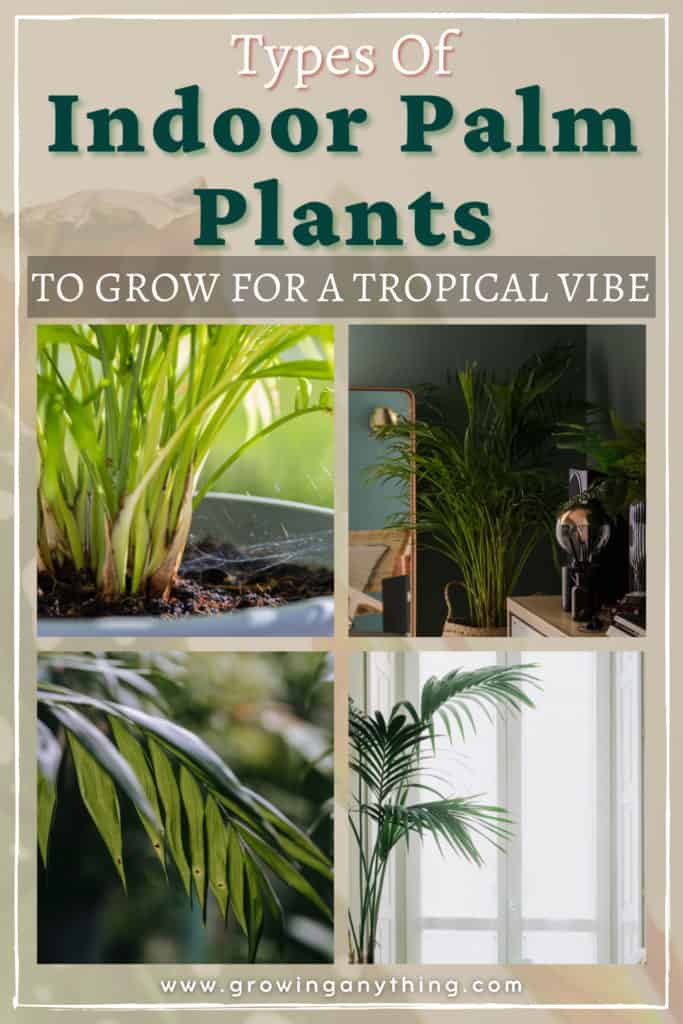10 Difference Types of Indoor Palm Plants
Are you searching for the types of indoor palm plants to grow in your home? Luckily, you’ve got plenty of choices!
The indoor palms don’t need any hard-to-achieve conditions. As long as you keep the room temperature to warm, average humidity, and ensure they get enough sunlight, your indoor palms will thrive.
Because of it, these palms are excellent plants to grow indoors because they won’t need time-consuming care.
Growing a palm in your home brings a charming, tropical vibe to any space and can transform your interior.
Other than occasional attention, indoor palms grow best when you know a few tips. For example, you should never put a palm near an AC unit because palms don’t like sudden temperature changes. Also, palms don’t like over-watering or overfertilization. Using a fertilizer from March to October is only recommended because it is an active growing period.
Check out the best palms to grow in your home!
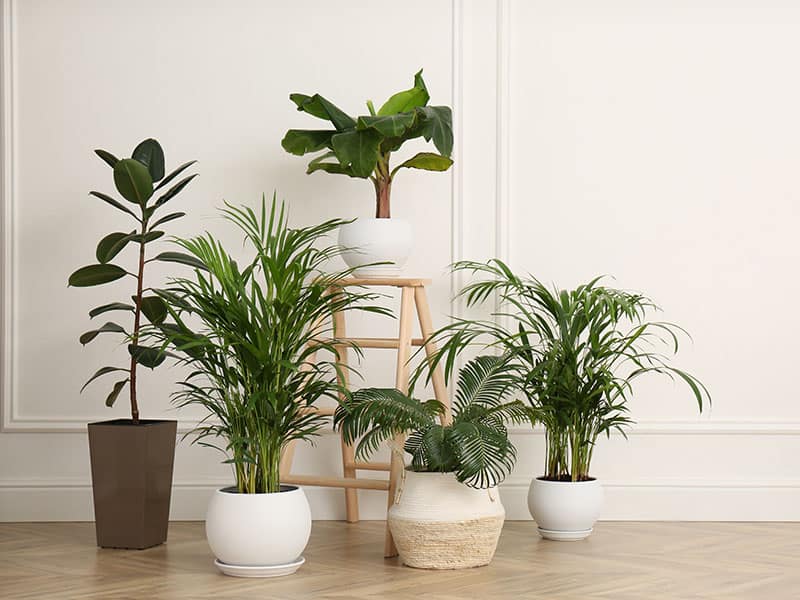
#1 Kentia Palm
Howea Forsteriana or Kentia palm is a top pick for people who like a tall palm to become a focal point in their homes. It is also one of the best and easiest to grow palms in the pots.
Kentia palm features typical palm-shaped foliage and can grow up to 12 feet indoors. However, the palm might need several years to fully mature and grow to the tallness you want.
Kentia palm has white flowers and may produce first fruits after more than ten years.
The palm is easy to grow, as it can adjust to different soil types. It is a drought-tolerant palm and a very forgiving palm. You can bring the palm outdoors in the summer, but ensure the palm is protected from direct sunlight. The same applies to indoor growing conditions.
You can use fertilizer to prevent potassium efficiency, which you can recognize on the tips of the leaves.
Another great thing about Kentia palm is that it doesn’t require excessive pruning. All you have to do is remove the dead leaves, by gently pulling them off.
Learn how to grow Kentia palm in containers with minimal care!
Discover interesting and practical tips for healthy Kentia palm. You should see the video below:
#2 Parlour Palm
Because of its elegant appearance, the Parlour palm is loved by interior designers. They use it as one of the main decorations in common rooms. The Latin name of this beautiful indoor and outdoor palm is Neanthe bella or Chamaedorea elegans.
There are several reasons why Parlour palm is excellent for homes. It looks wonderful, and it is cheap and thrives in places where other plants won’t! Moreover, Parlour palm can improve indoor air quality. Because of its minimal care and lovely look, Parlour palm is a great palm to start with or use to enhance your household plant collection.
The palm, like many other palms, is a slow grower. But, after several years, you can expect it to reach two feet.
Parlour palm adapts to different light conditions, but essentially enjoys morning or late afternoon sun. The plant also doesn’t like too much water, which means it is a great palm for people who travel a lot or forget to water their plants.
Find out why the Parlour palm doesn’t like repotting!
#3 Bamboo Palm
Bamboo palm or Chamaedorea seifrizii is an attractive household palm that grows in low light conditions. However, if you can ensure more light to your Bamboo palm, it will grow taller. On average, Bamboo palm gets between three and five feet tall when mature.
In most areas in the USA, Bamboo palm can only be grown indoors. But, if you live in US hardiness zones 10 and 11, you can grow your Bamboo palm outdoors.
The success of growing Bamboo palm depends on the state of the plant at the moment of buying it. If you get a healthy Bamboo palm with dark green foliage and erect stems, the plant requires minimal care and can easily adjust to the conditions in your home. Avoid palms with wilting, brown leaves.
When growing Bamboo palm, the initial steps after purchasing are essential for healthy growth. You need to transplant the plant after purchasing, into a pot with good drainage. Ideally, pick a pot that is around two inches larger than a pot the palm came in.
After proper transplantation, the Bamboo plant requires filtered water, average room temperature, and a nice amount of water.
But, the Bamboo palm is prone to pests and disease. Discover what pests and diseases to keep an eye on for your Bamboo palm.
#4 Lady Palm
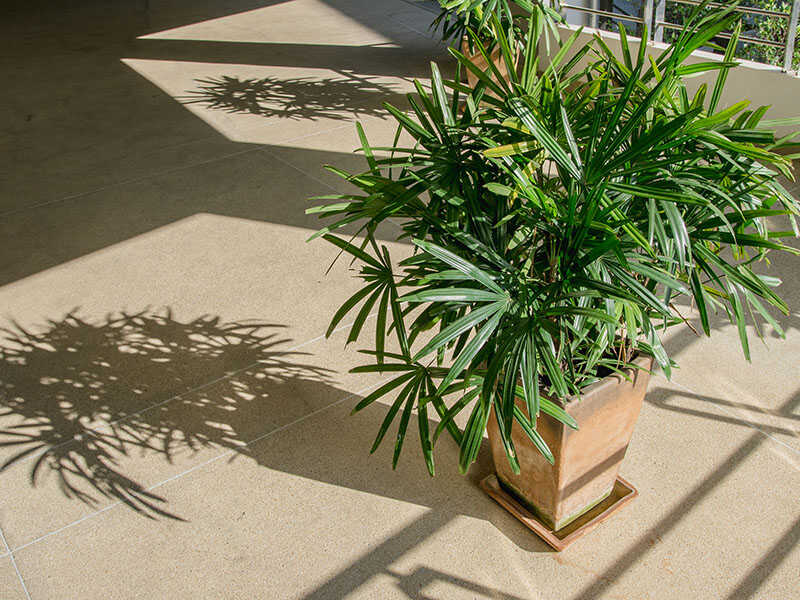
Broadleaf Lady palm, or more specifically, Rhapis Excelsa is a delicate, but charming palm to grow indoors. The palm has dark green, rich, and wide leaves, and gives a beautiful tropical feeling to every room.
It is one of the palms that grow better in containers than in soil. People grow it indoors, but also outdoors for landscaping and decorating entryways.
In ideal conditions, Lady palm grows up 12 feet. But, it rarely gets that tall indoors. Also, cultivars of the Lady palm are much smaller and compact, and made for indoor use, especially in smaller rooms.
The ideal location for Lady palm is a room corner that gets enough sunlight from the nearby window. Also, keep in mind that the palm requires regular watering and fertilizer, especially during summer.
In general, Lady palm is easy to grow and doesn’t require some special skills. However, wait for the fronds to get fully brown to remove them. Also, with a Lady palm, you don’t have to think about pests and diseases, as these palms are robust and resilient.
Check more compelling information about Rhapis Excelsa!
#5 Pygmy Date Palm
Phoenix Roebelenii or popular Pygmy Date palm is a stunning palm that differs from similar varieties by its narrow leaflets. The plant is a slow grower, most commonly grown for ornamental purposes. Because it can grow between four and six feet, the plant is suitable for most homes.
The plant has feather-like foliage, similar to the dwarf coconut palm. Pygmy palm also has an attractive trunk with a rich brown color.
Overall, the palm doesn’t require complex care. To improve the effect, you can grow several Pygmy date plants from seedlings distributed next to each other. It will create a fuller and more bushier appearance.
The palm ideal growing conditions are an average room temperature between 65 and 75 degrees Fahrenheit. Phoenix Roebelenii thrives in bright light but with alternating episodes of shade and light.
The plant needs frequent watering in spring and summer, but be careful not to over-water it. It may cause root problems and kill the plant. Additionally, like with some other palm varieties, use distilled water to prevent potential issues.
Discover more about growing Pygmy palms indoors!
#6 Chinese Fan Palm
Livistona Chinensis is a popular variety of fan palms, equally popular for growing indoors and outdoors. The palm can get up to six feet tall, but it will take several years.
When choosing a Chinese fan palm, be careful. Pick a healthy plant with rich green foliage and upright stems. These plants are more likely to thrive and require minimal care.
Ensure well-draining soil and keep it moist during the growing season. However, with Livistona Chinensis you need to avoid oversaturation because it can cause rotting. The ideal temperature for the Chinese fan palm to thrive is between 55 and 60 degrees.
Also, never put your palm near the AC unit, heating or cooling devices because these palms don’t tolerate sudden temperature changes.
They only need around four hours of sunlight to grow to their full potential.
Read what precautions to take to ensure your fan palm stays vital!
#7 Majestic Palm
Majestic palm, or Majesty palm or Ravenea rivularis is more commonly grown indoors than outdoors in the USA. It looks similar to Kentia palm until it grows up.
Majesty palm is a slow grower, and won’t grow over 1 foot per year.
Despite its beautiful appearance, Majesty palm isn’t suitable for beginners in gardening, as it is a bit tricky to grow. It requires optimal balance in fertilization, moderate temperature, optimal sun exposure and watering.
Most gardeners make mistakes when it comes to fertilization, giving the plant too many nutrients, without providing enough sun.
In most cases, Majesty palm thrives in bright indoor spots, with a lot of water and small amounts of fertilization. The ideal temperature range for the Majesty palm to grow is between 65 and 85 degrees Fahrenheit, but with high humidity. You can always use a humidifier to keep the optimal humidity in the room and mist the plant every day.
Check out the more detailed guide on how to grow Majesty palm indoors!
With these tips, caring for Majesty palm becomes simple, the video below should be able to help you:
#8 Areca Palm
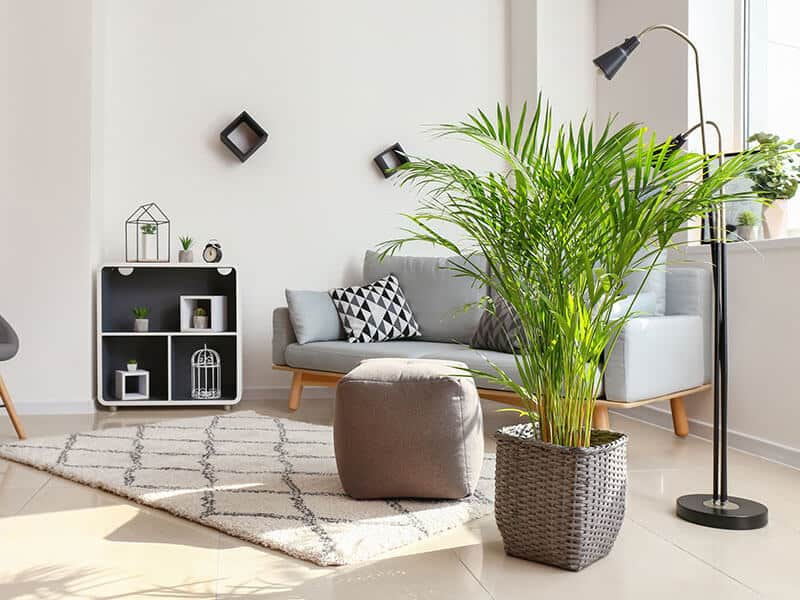
Chrysalidocarpus lutescens or Areca palm, Golden Cane Palm, and Butterfly palm come from Madagascar. It is the most common palm to use indoors when there is a lot of sunlight. Not only is Areca palm non-toxic to humans and animals, but the plant can help filter the toxins in the air.
As you probably anticipate, Areca palm requires bright light, but indirect. If you keep it on the sunny balcony, the heat and sunlight may burn the foliage. Therefore, find a sunny place near the window.
Indoors, Areca palm can grow up to 12 feet, but outdoors, in US hardiness zones 10 and 11, you may find 30 feet tall Areca palms!
Another thing to keep in mind when growing Areca palm is the proper repotting. If your palm gets all the necessary conditions, you will have to repot it every three years. However, never choose a too big pot.
A rule of thumb to follow is to always repot Areca palm in a new pot that is three inches larger than the current one.
Using a diluted fertilizer during spring and summer may help your Areca palm to grow faster!
More things to know before you bring home your new Areca palm!
#9 Sago Palm
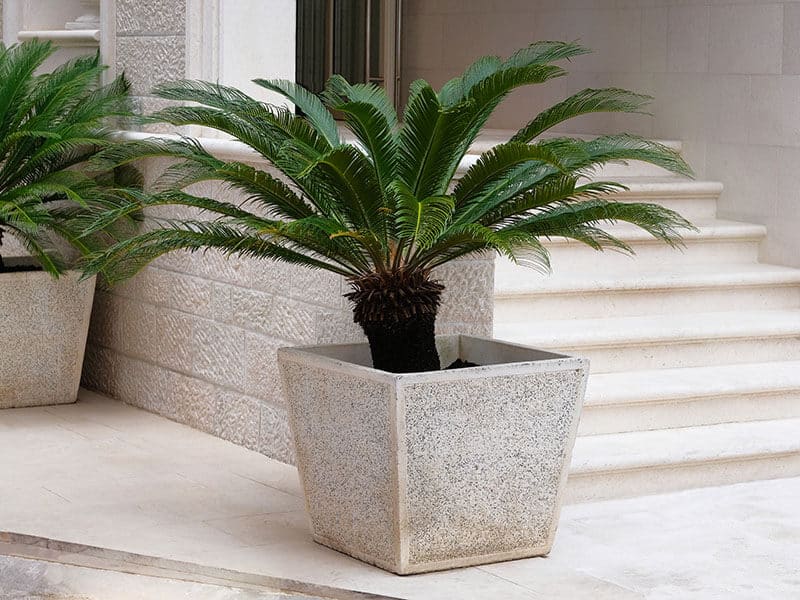
Sago palm or Cycas revoluta is a distinctive-looking small, shrub-like household palm. In fact, Sago isn’t a typical plant at all. As its botanical name suggests, Sago is a cycad, a type of ancient plant that has been around for almost the beginning of time.
The plant is quite easy to grow indoors and looks wonderful. The downside is the toxicity. Sago palm is extremely poisonous to humans and animals.
Sago plant is native to Japan and India. In their native habitats, Sago palms can reach up to 12 feet. But, they grow much slower and shorter indoors. The majority of indoor Sago palms don’t grow over five feet.
This tropical plant enjoys warm temperatures and well-draining soil. It doesn’t need a lot of water, but constant humidity is great.
Sago palm thrives in bright but filtered light. Therefore, an ideal location for your container is a sunny windowsill!
Read the intriguing background of Sago palms!
#10 Cascade Palm
Cascade palm, Cat palm or, botanically, Chamaedorea cataractarum is a tiny palm that comes from Central America. You can grow it indoors and outdoors. It has dark green, glossy foliage that ensures the plant always looks fresh and healthy.
Because of its compact size, the Cat palm is perfect for apartments in which you don’t have enough space to grow bigger plants.
The maximum height of Cascade palm is around three feet. Because it produces shrubs, the Cat palm looks richer and fuller than most tiny single-trunk palms.
Cascade palm is beautiful but might be tricky for beginners. As with other palms, ensure you get a healthy young palm and repot it after purchasing. Don’t forget to use fertilizer after repotting to help the plant establish in the new potting mix.
These palms require temperatures above 60 degrees Fahrenheit and moderately frequent watering. Two waterings per week are suitable for most plants.
Lastly, partial shade is the ideal indoor location for Cat palm, which means several feet from the window. Also, don’t forget to prune the old leaves to prevent the disease from spreading to the entire plant.
Read the full, step-by-step guide on Cat palm maintenance.
Find out why Cat Palm makes an excellent indoor plant, watch this video to know more:
Tropical Paradise Indoors With Carefully Choose Indoor Palms
As you can see, there are several indoor palms that you can grow successfully indoors! My list included the low-maintenance palms and the ones that require more skill and patience to grow.
Each of them has a distinctive palm appearance that can make you feel warmer just by looking at them!
Which one will you choose? I prefer Parlour and Majestic palm.
If the article helped you make up your mind, please, don’t forget to give it a thumbs up and to share it with your friends and family!
